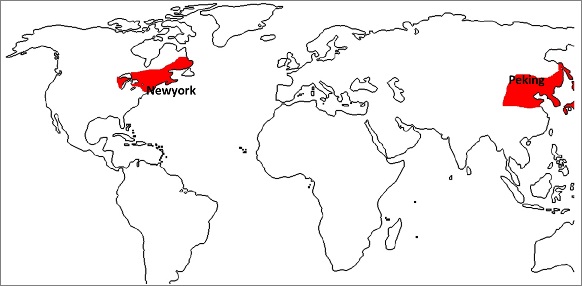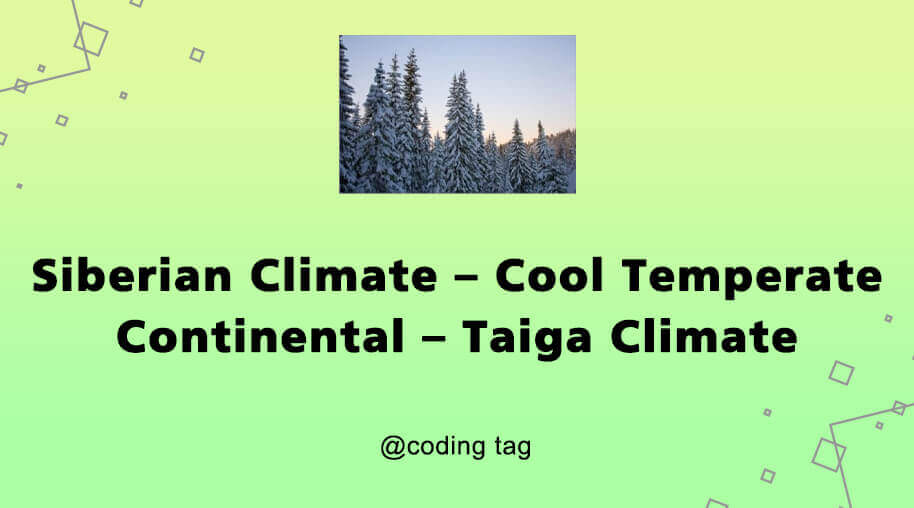Laurentian Climate – Cool Temperate Eastern Margin
by Devender
0 3143
This type of climate is an intermediate between the British and Siberian types of climate. It has features of both maritime and continental types of climate.
Laurentian Climate – Cool Temperate Eastern Margin
The Laurentian type of climate is only found in two regions both laying the N-Hemisphere. One is N-E North America (Eastern Canada including Newfound land and N-E USA including Maritime provinces and the New England States) while the other one is Eastern coastlands of Asia including Eastern Siberia, North China, Manchuria, Korea and Northern Japan.
- This type of climate is absent in the S-Hemisphere because only a small section of southern continents extend beyond 40 Degree South
- Neither continental nor eastern margin type of climate exists because the maritime influence is very high
- Laurentian Climate:
- The annual precipitation is approx. 75 to 150 cm
- Rainfall is present throughout the year (except interiors of China)
- However, 2/3rd of the rainfall is received in summers
- The uniformity of precipitation is because of the Atlantic influence and that of Great lakes
- Asiatic Region:
- The mountainous interior of China receive great continental effects
- It is as such that the intense heating in summer creates a region of extremely low pressure
- The moisture-laden winds from the Pacific and Sea of Japan blow in as S-E monsoon
- It is also known as cool temperate monsoon climate
- Natural Vegetation of Laurentian Climate:
- Agricultural Development of Laurentian Climate:
- The most outstanding activity of this region is fishing
- It is very important especially in Newfoundland and Japan because of their geographical importance
- Japan also makes use of fish wastes, fish meals, and seaweeds as fertilizers
- It is among one of the few countries that are involved in seaweed cultivation on submerged coastal farms
- Pearl Culture is also an aspect of Japanese fishing
- It is obtained from the shale fish known as pearl oysters found deep inside the sea
The Laurentian type of climate is characterized by cold, dry winters and warm, wet summers. The winter temperature may fall well below the freezing point while the temperature in summers is as warm as the tropics approx. 25 Degree C. Snowfall to great depths is possible in winters while the summers can be even warmer if the cold effects of the off-shore cold currents from the arctic are not present.

There is uniformity in precipitation with a slightly late summer maximum in the months of July and August which is a remarkable characteristic of the N-E American region in the Laurentian type of climate. The moisture content of the easterly winds from the open Atlantic is increased by the warm Gulf Stream and the prevailing westerlies penetrating the Rockies carry depressions over the Great lakes to the New England states promoting wet conditions especially in winters.
It is very vital for the agricultural activities of this region. Dense, Fog, and precipitation are produced due to the meeting of the warm Gulf Stream and cold Labrador Current on the coastal areas of Newfoundland.
The Asiatic region has far less uniformity in rainfall distribution as compared to the American region. The winters are cold and very dry while the summers are very warm and wet. The rainfall is confined to five summer months and the rest of the year is dry same as the tropical monsoon climate of India.
The insulation of Japan and meeting of cold and warm ocean current modifies the climate of Japan enabling it to receive adequate rainfall from both the SE monsoon in summers and NE monsoon in winter. The NE monsoon is a dry, cold wind from mainland Asia. It gathers sufficient moisture after crossing the sea of Japan bringing heavy rainfall or snow on the western coast of Japan.
The rainfall is evenly distributed in two maximum seasons -
1 In June, the Plum rain
2 In September, the Typhoon rain
On the North of 50 Degree N latitude, the forests tend to be coniferous and in the Asiatic region (eastern Siberia and Korea), the coniferous forests are a continuation of the great coniferous belt of Taiga.
On the south of 50 Degree N latitude, deciduous forests come with oak, beech, maple and birch being the principal trees.
The most important economic industries of the Laurentian climate region are lumbering, timber, paper, and pulp industries. The long duration and severity of winters make agriculture very less important in this region. However, due to the maritime influence and heavy rainfall, some of the hardy crops such as potatoes, oats, rye and barley are raised but only for local needs.
Due to the meeting of warm and cold ocean currents, the gently sloping continental shelves around the islands of Newfoundland and Japan are rich in Planktons. Fishes feed on these minute marine organisms which are abundantly present only in shallow waters adjacent to landmasses where the sunlight can penetrate through.

Share:







Comments
Waiting for your comments